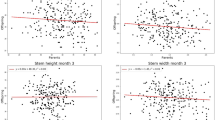Summary
Harvest index of grain crops is defined as grain yield divided by total plant yield. We estimated the heritability percentages of harvest index and its components, grain yield and plant weight, the genotypic and phenotypic correlations among these three traits, and the genotypic correlations of harvest index with plant height, 100-seed weight, grain number, and heading date by using a population of 1200 F9-derived oat lines tested in six environments. Furthermore, we examined the relative selection efficiencies of indirect selection for yield through harvest index and of index selection for yield through yield plus harvest index.
Heritability percentages were computed by use of variance-component, standard-unit, and realizedheritability methods. The heritability percentages for harvest index, grain yield, and plant weight were similar, and averaged between 50 and 65 precent across environments. Standard-unit and realized heritability percentages agreed closely and generally were lower than those computed via the variance-component method. Expected heritability percentages for harvest index calculated by using grain and plant yield data agreed almost exactly with actual values. Genotypic correlations were 0.88 between grain yield and plant weight, 0.42 between harvest index and grain yield, and −0.07 between harvest index and plant weight. Genotypic and phenotipic correlations were similar in magnitude. Theoretical and actual genotypic and phenotypic correlations of harvest index with grain yield and plant weight agreed closely. Genotypic correlations, computed via parent-offspring relationships, between harvest index and plant height, 100-seed weight, grain number, and heading date averaged −0.41, 0.43, 0.00, and −0.33 respectively.
Indirect selection for grain yield through harvest index was 43 percent as efficient as direct selection, and a selection index that combined harvest index and grain yield was no more efficient than direct selection for yield. Harvest index had little value as a selection criterion for grain yield improvement when unrestricted selection was used. Indirect selection for grain yield through harvest index, however, would be expected to retain lines with a more favorable combination of yield, plant height and heading date than would unrestricted direct selection for yield.
Similar content being viewed by others
References
Cannell, R. Q., 1968. The yielding capacity of cereal crops. J. Univ. Newcastle upon Tyne Agric. Soc. 22: 3–6.
Chandler Jr., R. F., 1969. Plant morphology and stand geometry in relation to nitrogen. In: Physiological aspects of crop yield. American Society of Agronomy, Crop Science Society of America. Madison.
Cochran, W. G., 1951. Testing a linear relation among variances. Biometrics 7: 17–32.
Dobben, W. H. van, 1962. Influence of temperature and light conditions on dry matter distribution, rate of development and yield of arable crops. Neth. J. agric. Sci. 10: 377–389.
Donald, C. M., 1962. In search of yield. J. Aust. Inst. agric. Sci. 28: 171–178.
Donald, C. M., 1968. The breeding of crop ideotypes. Euphytica 17: 385–403.
Frey, K. J., 1965. The utility of hill plots in oat research. Euphytica 14: 196–208.
Frey, K. J. & T. W. Horner, 1957. Heritability in standard units. Agron. J. 49: 59–62.
Grafius, J. E., 1965. A geometry of plant breeding. Mich. agric. Exp. Sta. Res. Bull 7. 59 pp.
Hazel, L. N., 1943. The genetic basis for constructing selection indices. Genetics 28: 476–490.
Holliday, R. & R. W. Willey, 1969. Variety potential in cereals and its improvement. Agric. Prog. 44: 56–77.
Kempthorne, O. & L. Folks, 1971. Probability, statistics, and data analysis. Iowa State Univ. Press. 555 pp.
Mc Ewan, J. M., 1974. The performance of semi-dwarf wheats in New Zealand. Implications for New Zealand wheat breeding. Proc. Fourth int. Wheat Genet. Symp. (In Press). Columbia. Missouri. 1973.
Nass, H. G., 1973. Determination of characters for yield selection in spring wheat. Can. J. Plant Sci. 53: 755–762.
Searle, S. R., 1965. The value of indirect selection. I. Mass selection. Biometrics 21: 682–707.
Sims, H. J., 1963. Changes in the hay production and harvest index of Australian oat varieties. Aust. J. exp. Agric. Anim. Husb. 3: 198–202.
Singh, I. O. & N. C.Stoskopf, 1971. Harvest index in cereals. Agron. J. 63: 224–226.
Smith, H. F., 1936. A discriminant function for plant selection. Ann. Eugenics. 7: 240–250.
Snedecor, G. W. & W. G. Cochran, 1967. Statistical methods. Sixth Edition. Iowa State Univ. Press. 593 pp.
Syme, J. R., 1970. A high yielding Mexican semi-dwarf wheat and the relationship of yield to harvest index and other varietal characteristics. Aust. J. exp. Agric. Anim. Husb. 10: 350–353.
Syme, J. R., 1972. Single plant characters as a measure of field plot performance of wheat cultivars. Aust. J. agric. Res. 23: 753–760.
TurnerHelen N., 1959. Ratios as criteria for selection in animal or plant breeding, with particular reference to efficiency of food conversion in sheep. Aust. J. agric. Res. 10: 565–580.
Turner, Helen N. & S. S. Y. Young, 1969. Quantitative genetics in sheep breeding., Cornell Univ. Press, 332 pp.
Vogel, O. A., R. E. Allan & C. J. Peterson, 1963. Plant performance characteristics of semi-dwarf winter wheats producing most efficiently in eastern Washington. Agron. J. 55: 397–398.
Author information
Authors and Affiliations
Additional information
Journal Paper No. J-7914 of the Iowa Agriculture and Home Economic Experiment Station, Ames, Iowa 50010, Project No. 1752.
Rights and permissions
About this article
Cite this article
Rosielle, A.A., Frey, K.J. Estimates of selection parameters associated with harvest index in oat lines derived from a bulk population. Euphytica 24, 121–131 (1975). https://doi.org/10.1007/BF00147176
Received:
Issue Date:
DOI: https://doi.org/10.1007/BF00147176




